Demographic Change in Scotland
This research paper sets out current evidence relating to demogrpahy in Scotland, exploring the implications of demographic change and related policy issues, with reference to Scotland's Population Growth Purpose Target
3. POPULATION AGEING
- Scotland's population is continuing to age, with a 50% increase in over 60s projected by 2033.
- There is a strong urban/rural dimension to the ageing population; while 17% of the population are over 60, this age group makes up 21% of the population in several rural local authorities.
- Scotland's dependency ratio is projected to increase from 60 per 100 to 68 per 100 by 2033.
- Age related public expenditure in the UK is projected to increase from 20.1% of GDP in 2007-8 to 26.6% in 2057.
Age structure of Scotland's population
3.1 The age profile of the population is as important as the total population size in policy terms, and this has to be borne in mind in considering Scotland's progress towards its population target. In simple terms, an ageing population is one with an increasing average age, where the proportion of older people is increasing and the proportion of younger people is decreasing. Like the majority of industrialised nations, Scotland's population is ageing as a result of a relatively low birth rate (below replacement level - see Section 5, Fertility) and increasing life expectancy. Table 3 below shows the numbers in broad age categories in the population in Scotland ( GROS 2009 mid year estimates).
Table 3: Scottish population by broad age bands (2008-9)
0-15 |
912,340 |
18% |
|---|---|---|
16 - 59/64 |
3,248,815 |
63% |
Over 60/65 |
1,032,845 |
20% |
Source: GROS mid year estimates 2009
Note: due to rounding the percentage figures may not sum to 100%.
3.2 The GROS 2009 mid year estimates show 18% of the population to be 15 or under, and 20% of the Scottish population to be over pensionable age (60 for women/65 for men). Those in the 60/65+ age group already outnumber those in the under 16 age group; this has been the case since the figures reported in the 2003 mid year estimates and the balance between old and young people in the population is continuing to shift.
3.3 To illustrate the extent to which Scotland's population is ageing, in the years 1999 to 2009 there has been a 8% reduction in the number of under 16s and a 12% increase in those in the 60-74 age group; the increase in the over 75s is higher still at 14%. The proportion of under 16s in the population decreased from 20% in 1999 to 18% in 2009, while the proportion of people of pensionable age increased from 18% to 20% in the same period.
3.4 It is important to note that the key determinant of the future structure of the Scottish population is the current population structure. Figure 3 shows that Scotland currently has an uneven age profile with a disproportionately large share of the population accounted for by those currently aged 36-55. This group will continue to influence Scotland's population structure in future years. The ageing of this 'cohort' is the key driver in the shift in Scotland's population profile over the period to 2033, described below.
Figure 3: Age distribution of Scottish population, 2009
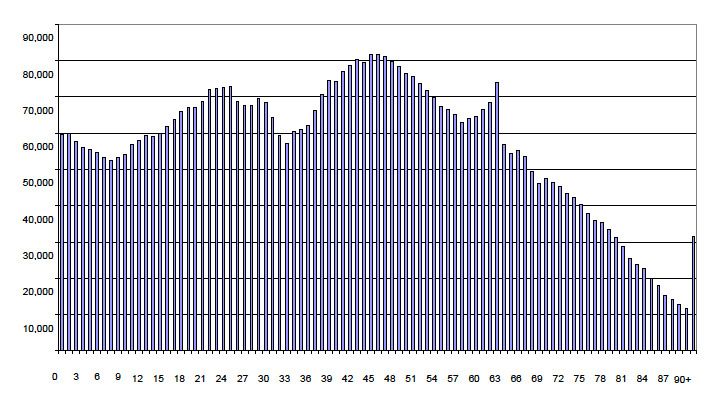
Source: GROS
3.5 Current projections suggest that there will be a 50% increase in the over 60s and a 4% decrease in the under 16s by 2033. Figures for the 75 and over age group show a projected increase of over 80%. These figures are driven by a relatively low birth rate, although increasing in more recent years (see Section 5, Fertility), and improvements in life expectancy in recent decades (see Section 4, Mortality, Life Expectancy and Healthy Life Expectancy).
3.6 Scotland's population is projected to age somewhat more rapidly than elsewhere in the UK. In Scotland and England the proportions of people of pensionable age (60 for men/65 for women) as at mid 2009 stand at 19.9% and 19.3 % respectively. Current statistics show the gap between the 2 figures to be widening; by 2033 the figures are projected to be 24.1% and 21.4% respectively (see Figure 4).
Figure 4: Estimated and projected population structure for countries in the UK (2008/2033)
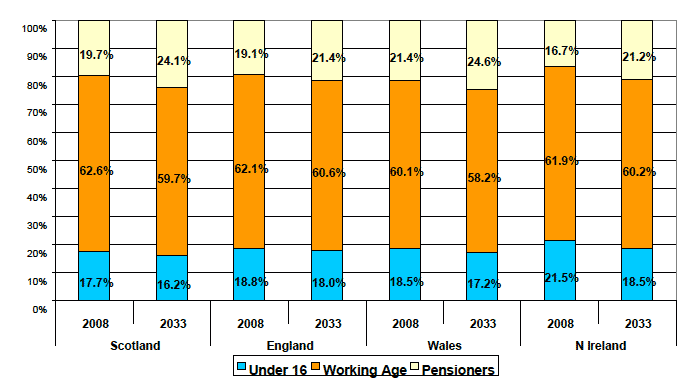
Source: ONS
3.7 Indeed, an ageing population is an issue for all European countries and while the UK, and Scotland in particular, face demographic challenges in the coming years, other European countries are facing a more severe situation, with Eurostat figures for 2009 showing Germany and Italy having the biggest proportion of over 65s in their populations at just over 20% (the Eurostat figure for the UK (2008) is 16.1%).
Geographical variation in population profile across Scotland
3.8 There is a clear urban/rural dimension to Scotland's ageing population. While 17% of the Scottish population are 65 and over ( GROS 2009 mid year estimates), the councils with the largest proportions of over 65s are predominantly rural (eg, Argyll and Bute, Eilean Siar, Dumfries and Galloway, South Ayrshire all at 21%). Age related migration is a key factor here. GROS figures show significant net out-migration from rural (and especially remote rural) areas in the 16-24 age group (with young people leaving for employment and education reasons). Rural areas also show net migration gains in the older age groups as people move away from urban areas in later life (see Table 4).
Table 4: Age and migration in urban and rural Scotland (2007-8)(%)
Age group |
Accessible rural areas |
Remote rural areas |
Rest of Scotland |
|---|---|---|---|
0-15 |
2.4 |
1.5 |
* |
16-24 |
-0.8 |
-5.3 |
1.8 |
25-34 |
4.9 |
2.6 |
0.3 |
35-44 |
2.9 |
2.1 |
-0.3 |
45 59/64 |
1.2 |
1.2 |
-0.1 |
Pension age |
0.1 |
* |
* |
All |
1.6 |
0.7 |
0.2 |
Source: GROS * less than 0.05%
3.9 The extent of geographic variation in projected population ageing is also evident from GROS figures (2008 based projections). While the 65 and over age group is set to increase from 17% to 25% of the Scottish population by 2033, the projected proportions range from 19% in Glasgow to 33.5% in Dumfries and Galloway, with other authorities with projected 65 and over populations of over 30% also being largely rural (eg, Eilean Siar, Shetland, Argyll and Bute, East Dunbartonshire, Angus).
Implications of an ageing population for the dependency ratio
3.10 The dependency ratio compares the number of those of working age within the population to dependants (under 16s and over pensionable age combined). This is a fairly crude indicator as it is based purely on age, and takes no account of labour market or education participation rates 13. In Scotland figures from the GROS 2009 mid year estimates show a dependency ratio of 60 (dependants per 100 population), with a fairly even balance between under 16s (28) and over 60/65s (32). Population projections show this ratio remaining fairly constant (overall and in relation to under 16s v over 60/65s) over the next 15 years, but an increase in the ratio thereafter driven by the projected rise in older people in the population 14. By 2033, current GROS projections (based on the 2008 mid year estimates) indicate a dependency ratio of 68 per 100, and a balance of 27 per 100 and 40 per 100 for under 16s and over 65s (see Figure 5). Thus it can be seen that the worsening dependency ratio is driven by the increasing number of older people in the population.
Figure 5: Scotland's dependency ratio (2008-2033)
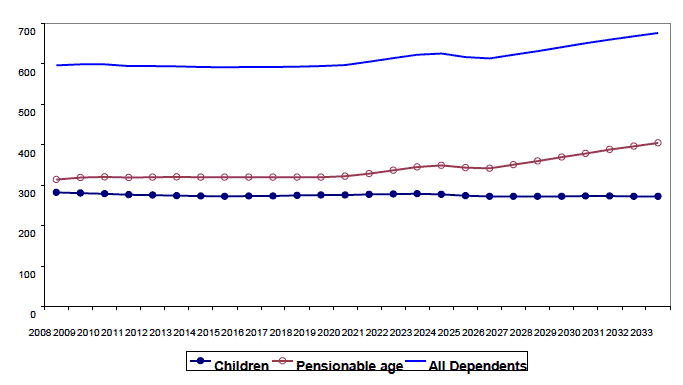
Source: GROS (2009)
3.11 The implications of an ageing population, and a worsening dependency ratio, are wide-ranging and complex. They include potential increased demands on public services (particularly from increased numbers of older people, although some of these pressures may be off-set by reduced demands for services from a smaller under 16 population, i.e. for education), and potential reduced tax revenues (unless older people work longer, a trend evident since 2002) to fund this increased demand as a result of fewer (or proportionately fewer) people aged 16 and over in employment. In this way, Scotland's demographics present clear challenges, but there are also opportunities and benefits to be explored, as touched on in relevant sections below.
Implications of an ageing population for the economy
3.12 The economic impacts of an ageing population are of key interest. As the population ages, the working age population will gradually shrink as a proportion of the whole population. McGregor et al carried out modelling work as part of the Scottish Demography Research Programme looking at the potential impacts of a reduction in the working age population. This work was published in 2007 with an updated paper published in September 2008 drawing on revised population projections. Their work examined a range of scenarios, involving different fertility, migration and life expectancy rates, and highlighted the general principle that a reduction in the working age population would lead to a tightening of the labour market, increased wage levels (as firms have to pay higher wages to attract workers from a declining supply of labour), higher prices and a loss of competitiveness in the international market. As a result of these impacts the analysis estimates that GDP (output) would be lower under such a scenario compared to one where the population remains unchanged from its current size and structure. Further, within the working age population itself the proportion of older workers to younger workers will increase. This can lead to increased competition for young workers who represent investment for the future and who may have different skill sets to older people already in the workforce.
3.13 The original work of McGregor et al was prompted by projections showing Scotland's population falling below 5 million and an anticipated significant decrease in the size of the working age population. The rise in Scotland's fertility rate and the increase in in-migration over recent years have resulted in more positive central population projections (see Figure 1), but it is far from clear as to whether these projections will be realised. In particular, the migration element of population change, which can adjust the working age population in the short term, is open to fluctuation and it is not clear whether the recent gains in net migration will be sustained in the longer term, and Scotland's ageing workforce and the less favourable projected dependency ratio continue to be key issues for Scottish public policy.
3.14 In an ageing population, one option for increasing the workforce is to encourage people to remain economically active for longer. The Labour Force Survey can be used to show labour market employment rates by age group. Figure 6, based on figures from 2008 (second quarter) in order to highlight the pre-recession situation, shows that the employment rate increases for each age group up to the 45-49 group (when it is around 87%), after which rates decrease steadily to around 45% for the 60-64 age group.
Figure 6: Scottish employment rates by age groups (2008)
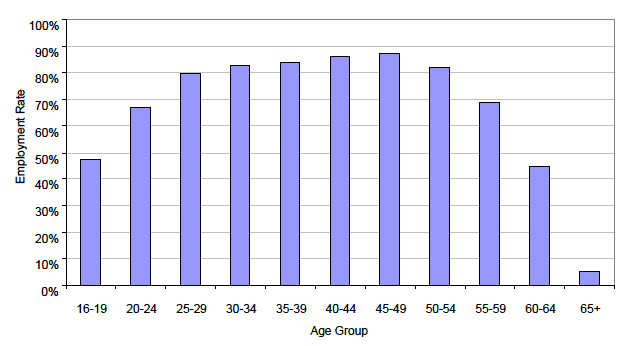
Source: Labour Force Survey, April-June (Q2) 2008
3.15 With an increasingly higher proportion of the workforce falling into the older age groups, lower employment rates in these age groups may impact on overall labour market participation. However, growth in employment rates has also varied across age groups in recent years with the highest rates of increase experienced across the older age groups (see Figure 7).
Figure 7: Percentage point change in employment rates by age group, 1999 to 2008
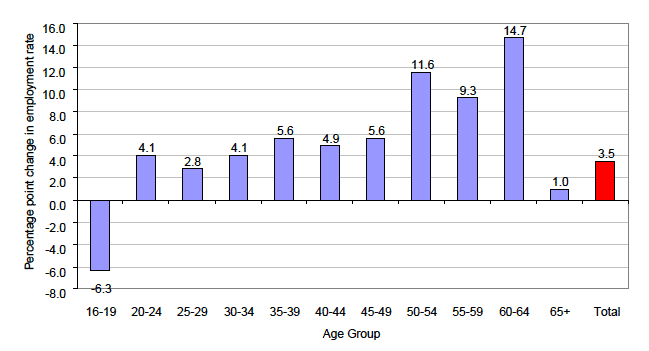
Source: Labour Force Survey, April-June (Q2) in each year
3.16 This analysis precedes the impact of the recession on the labour market. Analysis covering the 2 year period to 2010 second quarter (April-June) shows that during the downturn there has been a relatively larger decline in employment rates for younger workers compared to older workers (see Table 5). For example, over this 2 year period the employment rate for the 50-64 age group in Scotland has declined by 2.5 percentage points, compared to a fall of 3.9 percentage points for the 18-24 age group over the same period. The latest figures also indicate that during the recession there has been an increase in employment for those above retirement age in both Scotland and the UK. It will be interesting to see how, and to what extent, these labour market trends are maintained.
Table 5: Employment rate by age group, data for period April to June 2010 (not seasonally adjusted)
Age Group |
Scotland |
||||
|---|---|---|---|---|---|
Rate |
Change on year |
Change on 2 years |
|||
18-24 |
61.3 |
? | -1.4 |
? | -3.9 |
25-34 |
77.6 |
? | -1.8 |
? | -3.5 |
35-49 |
80.5 |
? | -1.6 |
? | -5.1 |
50-64 |
63.3 |
? | -1.7 |
? | -2.5 |
All 16-64 |
70.2 |
? | -1.9 |
? | -4.1 |
Source: Labour Force Survey, ONS
3.17 The coming years will see changes to the pension age for women, and both men and women thereafter, with a recent announcement as part of the UK Spending Review (October 2010) of the raising of the UK pension age to 66 (for both men and women) by 2020; the timetable for further changes thereafter is still to be confirmed. In addition, there are plans to phase out the default retirement age (the age at which employers can legally force someone to retire). These changes (in line with policy considerations in many others countries) will impact on participation rates, encouraging women and men to stay in the labour market for longer (and increasing the overall supply of labour). Indeed, research indicates that many older workers would be happy to work beyond the current retirement age (eg, CROW, 2004) - albeit not necessarily on a full-time basis, and with a range of motivations - and the removal of the default retirement age will allow them to do so.
3.18 However, the potential interaction between labour market participation and the demands of caring for relatives and friends (eg, caring for partners and parents) and providing childcare for grandchildren should be noted. The need (or wish) to take on a caring role or provide childcare for younger relatives may impact on the potential for increased labour market participation amongst older age groups. Alternatively, increasing numbers of older people remaining within the workforce may impact on the availability of carers or "child-carers" within this age group. In relation to childcare, for example, the Growing Up in Scotland ( GUS) survey 15 found grandparents to be the main providers of childcare for almost half (47%) of children aged 0 to 3. Any reduction in this resource may impact on labour market participation of younger women with children or, alternatively, fertility among younger women, given that the availability of informal childcare/local family support may be a factor in fertility decisions 16. If demographic change results in a lower, or potentially negative, contribution from growth in labour market participation to economic growth rates then this will have to be compensated by higher rates of growth in other areas. This could be achieved through a variety of factors, including: (1) encouraging more potential workers to move from inactivity into employment; (2) increasing the average hours worked (which would boost overall levels of labour input); and/or (3) seeking to improve overall productivity levels, so that higher levels of output can be produced with the same level of inputs (i.e. labour and capital).
3.19 It is, of course, important that the debate also recognises the potential positive implications of an ageing population for the Scottish labour market and economy (as well as society as a whole). Analysis by David Bell indicates how demand for formal paid care services will rise over the coming years bringing a potential increase in jobs in this sector 17. This is primarily linked to the increasing numbers of older people in the population, but Bell argues that an increasing "deficit" in unpaid care will also be a factor. He suggests that this deficit will come about as a result of increasing life expectancy and family migration patterns: people will live longer and have more years when they may have care needs, but may have fewer younger relatives nearby who may provide such care, and that such patterns would be particularly apparent in rural areas which have the highest proportions of over 65s, and the greatest levels of out-migration of younger people. However, the likely extent of any such "deficit" is not clear. As people live longer lives and have more years in good health, older people themselves are likely to provide more care in the future. In addition, younger relatives who no longer live nearby may still provide some care; for example, some people may be cared for by paid carers during the week, and by relatives at the weekend.
3.20 In addition to paid carers, Graham et al (2007) note the increase in demand for other goods and services linked to an ageing population. Most obviously, this might include relevant medical and healthcare professionals, and manufacturers and suppliers of equipment and adaptation supporting independent living. However, those older workers who remain in the workforce for longer (and indeed the affluent retired) will pay taxes and continue to be important consumers of goods and services across a range of sectors. Further work by David Bell has also looked at this issue, citing economic analysis that indicates no significant link between changes in the proportion of older people in the population and economic performance. Bell also looks at age-related patterns of consumer spending and concludes that an ageing population will present important opportunities as well as challenges 18. Thus, employment opportunities and economic growth may increase as a result of the ageing population.
Implications for public spending
3.21 Analysis by HM Treasury in March 2008 estimated that around a half of all current public sector spending at the UK level is age related 19 (see Figure 8). HM Treasury figures 20 show this balance is set to change over the coming years, with age related expenditure increasing from 20.1% of GDP in 2007-8 to 26.6% of GDP in 2057; over the same period, other spending is projected to go from 20.4% of GDP to 18% of GDP. While some age related expenditure is linked to children (and increases are projected in education spending), the biggest increases are projected to come in relation to state pensions and health care, both of which are projected to increase by more than 2 percentage points. Long term care expenditure is projected to increase by around 0.8 percentage points.
Figure 8:
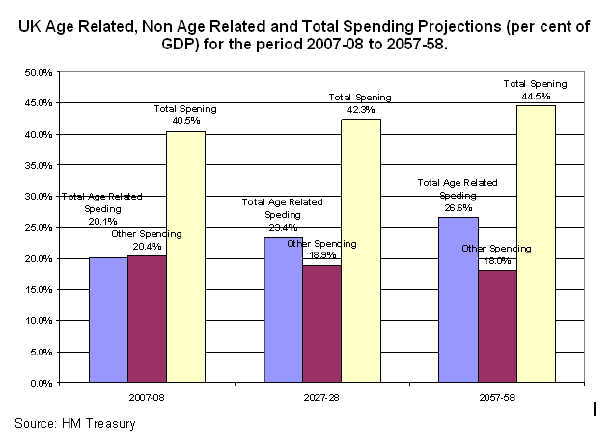
3.22 For services currently devolved to Scotland, the relative impact of the projected increases in expenditure will be influenced by the size of the change in population structure in Scotland relative to the rest of the UK. Figure 3 (at para 3.5 above) which uses the central (principal) projection for each country in the UK, shows that Scotland is projected to experience a relatively sharper increase in the proportion of the population that is of pension age between 2008 and 2033. In relation to Free Personal and Nursing Care, a policy currently unique to Scotland, expenditure has risen since its introduction in 2002 in line with the increase in numbers benefiting from the policy. For those in care homes, expenditure has risen from £83.3m in 2003-4 to £101.5m in 2007-8. For those at home, expenditure across Scotland has risen from £128.6m to £256.7m over the same period 21. It is anticipated that these figures will continue to rise with the increased number of people living longer into old age.
Policy considerations related to an ageing population
3.23 Responding to Scotland's ageing population gives rise to a number of policy considerations focusing on the changing balance of older and younger people in the population. Key amongst them are:
- Consideration of how the labour market participation rate can be increased for older age groups
- Consideration of how public services, and age related public services in particular, can be funded as the proportion of the population of working age continues to fall.
Determinants of the ageing population
3.24 This section has looked broadly at the characteristics and implications - both positive and negative - of an ageing population in Scotland. Population ageing is, though, determined by trends in mortality and fertility, both of which are examined in greater detail in the following sections. Section 4 (Mortality, Life Expectancy and Healthy Life Expectancy), in particular, covers a number of issues related to increased numbers of older people in the population and which are commonly associated with an "ageing population". Migration (or at least net in-migration) (covered in Section 6) will tend to have a moderating effect on population ageing, as migrants generally increase the working age population. The material presented includes discussion of trends, policy implications and policy activity which are relevant in their own right, but combine to determine the extent of the ageing population.
There is a problem
Thanks for your feedback